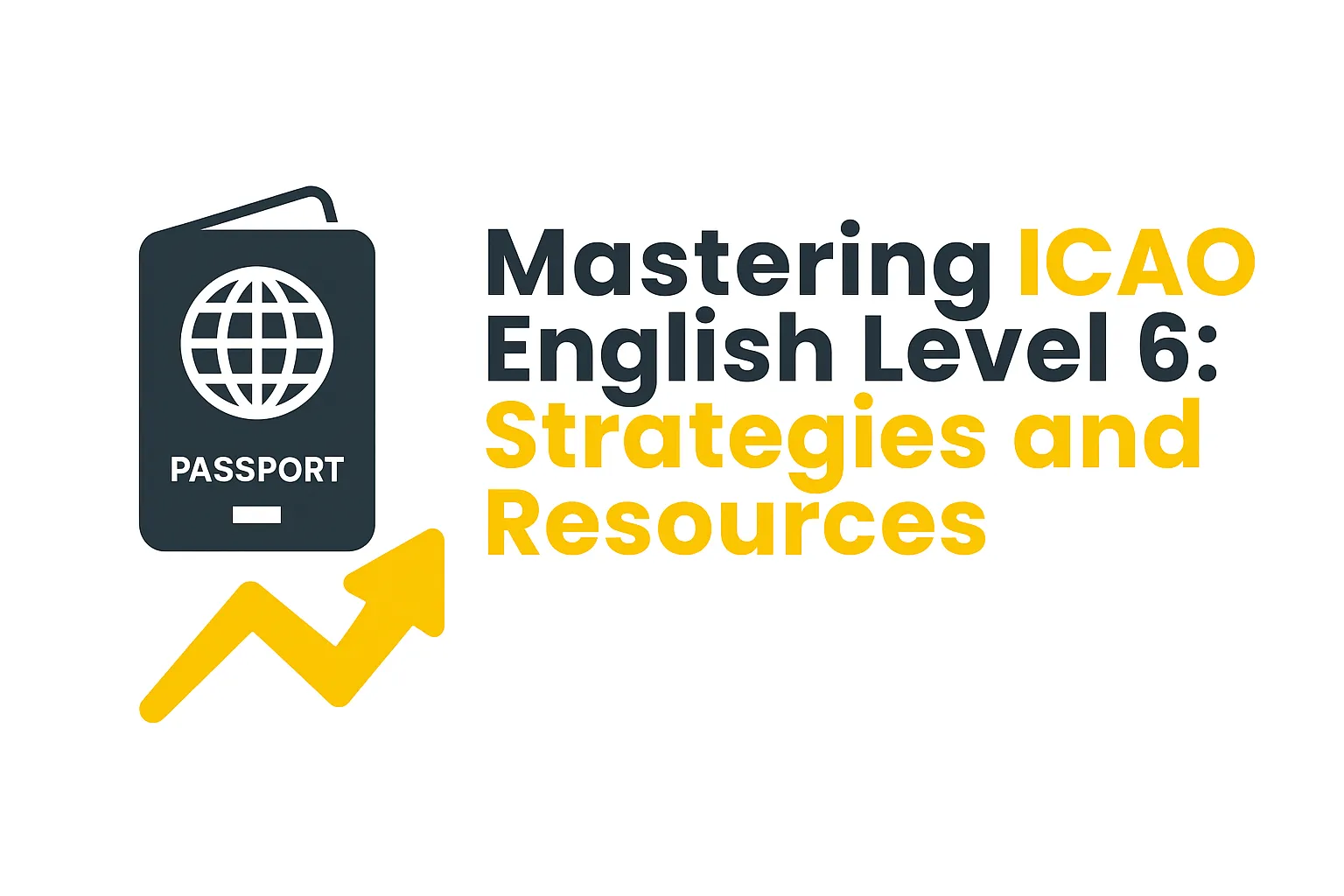Achieving ICAO English Level 6 is the pinnacle of aviation English proficiency, signifying near-native fluency and the ability to communicate effortlessly in complex aviation scenarios. For pilots and air traffic controllers, reaching this level not only ensures compliance with International Civil Aviation Organization (ICAO) standards but also enhances career longevity, as Level 6 certification requires no retesting. At icaospeak.com, we provide tailored ICAO English training to help you master this advanced level. This comprehensive guide explores proven strategies, essential resources, and expert tips to achieve ICAO English Level 6, empowering you to excel in the ICAO English test and thrive in international aviation.
Whether you’re a student pilot aiming high or a seasoned professional seeking to upgrade your proficiency, this 3,000+ word blog offers actionable insights to help you succeed. Let’s dive into the strategies and resources that will guide you to ICAO Level 6.
Understanding ICAO English Level 6
The ICAO Language Proficiency Requirements (LPRs), established in 2008, standardize English communication for aviation safety. The ICAO English test evaluates six skills—pronunciation, structure, vocabulary, fluency, comprehension, and interactions—on a scale from 1 to 6. Level 6, the highest level, indicates expert proficiency, characterized by:
- Pronunciation: Near-native clarity, with minimal accent interference.
- Structure: Complex sentence structures used accurately.
- Vocabulary: Extensive, precise use of aviation and general terms.
- Fluency: Smooth, natural speech, even in high-pressure scenarios.
- Comprehension: Near-perfect understanding of diverse accents and contexts.
- Interactions: Confident, effective responses in routine and non-routine situations.
Achieving Level 6 is challenging but offers significant benefits, including global recognition and exemption from retesting, unlike Levels 4 and 5, which require periodic reassessments. This makes it a valuable goal for pilots and controllers involved in international operations.
Ready to aim for the top? Explore our ICAO English test preparation resources at icaospeak.com to start your journey.
Why Aim for ICAO English Level 6?
Pursuing ICAO English Level 6 offers numerous advantages for aviation professionals:
- Career Longevity: No retesting required, saving time and costs over your career.
- Global Opportunities: Recognized by EASA, FAA, and other aviation authorities, opening doors to international airlines.
- Enhanced Safety: Expert-level communication reduces the risk of miscommunication in critical situations.
- Professional Credibility: Demonstrates superior aviation communication skills, boosting your reputation.
- Competitive Edge: Stands out on applications for elite roles or airlines with stringent language requirements.
At icaospeak.com, our advanced ICAO English training is designed to help you achieve these benefits. Book a 1-on-1 training session to get started.
Challenges of Achieving ICAO English Level 6
Reaching Level 6 requires overcoming significant challenges, as it demands near-native proficiency. Common hurdles include:
- Complex Scenarios: Handling non-routine situations, like emergencies or technical discussions, with fluency.
- Accent and Pronunciation: Minimizing accent interference while maintaining clarity across diverse contexts.
- Vocabulary Breadth: Using precise, aviation-specific terms alongside general English fluently.
- High-Pressure Performance: Maintaining composure and fluency in stressful, time-sensitive scenarios.
Quality ICAO English courses and strategic preparation can address these challenges, helping you build the skills needed for success.
Proven Strategies for Mastering ICAO English Level 6
To achieve ICAO English Level 6, you need a structured approach that targets all six proficiency skills. Below are expert strategies to guide your preparation.
1. Master Aviation-Specific Communication
ICAO Level 6 requires fluency in ICAO phraseology and the ability to adapt to non-standard situations. Focus on:
- Standard Phraseology: Practice terms like “cleared for takeoff,” “squawk 7500,” and “go-around.”
- Non-Routine Scenarios: Role-play emergencies, such as engine failures or weather diversions, to build confidence.
- Aviation Contexts: Discuss topics like flight planning, navigation, or safety procedures with precision.
Our mock tests at icaospeak.com include realistic scenarios to prepare you for these challenges.
2. Enhance Pronunciation and Clarity
Clear pronunciation is critical for Level 6, as even minor accent issues can impact scoring. Strategies include:
- Phonetic Training: Work with a coach to refine stress, intonation, and vowel sounds.
- Mimic Native Speakers: Listen to ATC recordings or aviation podcasts to emulate clear speech patterns.
- Record and Review: Record your practice sessions and analyze areas for improvement.
3. Expand Your Vocabulary
A broad, precise vocabulary is essential for Level 6. Focus on:
- Aviation Terms: Learn technical terms like “altimeter setting,” “VOR,” and “runway incursion.”
- General English: Use advanced synonyms and idiomatic expressions to demonstrate fluency.
- Contextual Usage: Practice applying vocabulary in aviation discussions, such as describing weather phenomena.
4. Build Fluency Under Pressure
Fluency at Level 6 means speaking naturally, even in high-stakes scenarios. Try:
- Role-Playing: Simulate ATC-pilot interactions or emergency briefings.
- Timed Responses: Practice answering questions within 10–15 seconds to mimic test conditions.
- Stress Management: Use breathing techniques to stay calm during complex discussions.
5. Improve Comprehension Skills
Understanding diverse accents and rapid speech is crucial. Strategies include:
- Listen to ATC Recordings: Access live ATC feeds (e.g., LiveATC.net) to practice with real-world communications.
- Diverse Accents: Expose yourself to English spoken by non-native speakers from Europe, Asia, and beyond.
- Active Listening: Summarize or paraphrase recordings to improve retention.
6. Practice Interactive Communication
Level 6 requires seamless interactions. Focus on:
- Clarification Skills: Practice asking for clarification politely (e.g., “Can you repeat that, please?”).
- Negotiation: Role-play scenarios requiring persuasion, like requesting a different runway.
- Confidence: Engage in mock interviews to build rapport with examiners.
Our 1-on-1 training at icaospeak.com offers personalized coaching to refine these skills.

Essential Resources for ICAO English Level 6 Preparation
To succeed, leverage high-quality resources tailored to ICAO English Level 6. Below is a table comparing top resources, followed by detailed recommendations.
1. icaospeak.com: Personalized Coaching and Mock Tests
Our advanced ICAO English training at icaospeak.com is designed for Level 6 aspirants. Priced at €29 per hour, our 1-on-1 coaching offers:
- Customized Lessons: Tailored to your weaknesses, such as pronunciation or fluency.
- Mock Tests: Realistic simulations (€69) with examiner feedback.
- Aviation Focus: Practice with radio phraseology and emergency scenarios.
- EASA Compliance: Recognized by EASA and ICAO, ensuring global acceptance.
Schedule your 1-on-1 training session to start preparing today.
2. ICAO Doc 9835: Official Guidelines
The ICAO Aviation English Language Test Services provides Doc 9835, the official guide to language proficiency requirements. It details:
- Rating scale criteria for Level 6.
- Sample test tasks and evaluation standards.
- Best practices for aviation communication.
Pros: Authoritative and free. Cons: Dense and not beginner-friendly.
3. LiveATC.net: Real-World Listening Practice
LiveATC.net offers free access to ATC communications, ideal for practicing comprehension and vocabulary.
- Pros: Realistic, diverse accents, free.
- Cons: Lacks structured guidance.
Step-by-Step Plan to Achieve ICAO English Level 6
To master ICAO English Level 6, follow this 8-week preparation plan:
Weeks 1–2: Assess and Build Foundations
- Assess Your Level: Take a practice test to identify strengths and weaknesses.
- Study Basics: Review ICAO phraseology and aviation vocabulary.
- Resource: Use our mock test for baseline assessment.
Weeks 3–4: Focus on Pronunciation and Vocabulary
- Practice Pronunciation: Work with a coach to refine clarity and intonation.
- Expand Vocabulary: Learn 10–15 new aviation terms daily.
- Resource: Book 1-on-1 coaching at icaospeak.com.
Weeks 5–6: Enhance Fluency and Comprehension
- Role-Play Scenarios: Practice emergency communications and ATC interactions.
- Listen Actively: Use LiveATC.net to understand diverse accents.
- Resource: Access ATC recordings and practice with our preparation resources.
Weeks 7–8: Simulate and Refine
- Take Mock Tests: Complete at least two full simulations to mimic test conditions.
- Refine Weaknesses: Focus on feedback from coaches or mock tests.
- Resource: Schedule a mock test for final preparation.
Common Mistakes to Avoid
Avoid these pitfalls when preparing for ICAO English Level 6:
- Overfocusing on Grammar: Prioritize fluency and interactions over perfect grammar.
- Neglecting Non-Routine Scenarios: Practice emergencies, as they’re critical for Level 6.
- Ignoring Feedback: Act on instructor critiques to address weaknesses.
- Underestimating Practice: Consistent, daily practice is essential for fluency.
Our coaches at icaospeak.com provide detailed feedback to help you avoid these mistakes. Contact us at icaospeak.com/contact for support.
Comparison: Level 6 vs. Lower Levels
| Criteria | Level 4 | Level 5 | Level 6 |
| Pronunciation | Understandable, accent may interfere | Clear, minimal accent impact | Near-native, no interference |
| Fluency | Basic flow, some pauses | Smooth, occasional hesitations | Natural, effortless |
| Vocabulary | Adequate for routine tasks | Broad, handles most scenarios | Extensive, precise |
| Retesting | Every 4 years | Every 6 years | None required |
Level 6 offers the most benefits, making it worth the effort for career-focused pilots.
Why Choose icaospeak.com for Level 6 Preparation
At icaospeak.com, our advanced ICAO English training is tailored for Level 6 aspirants:
- Expert Coaches: Certified instructors with aviation experience.
- Affordable Pricing: €29/hour for coaching, €69 for mock tests.
- EASA-Recognized: Globally accepted certification.
- Flexible Scheduling: Online sessions via Zoom, fitting your schedule.
- Fast Results: Test results within 3 business days.
Ready to achieve Level 6? Book your 1-on-1 training or try our mock test today.
Frequently Asked Questions
1. How hard is it to achieve ICAO English Level 6?
It’s challenging due to the need for near-native fluency, but structured training and practice can make it achievable.
2. How long does it take to prepare for Level 6?
Typically 8–12 weeks of dedicated practice (2–4 hours/week), depending on your starting level.
3. Do I need Level 6 for my career?
While Level 4 is the minimum, Level 6 enhances credibility and eliminates retesting.
4. What resources are best for Level 6 preparation?
Combine coaching (e.g., icaospeak.com), ATC recordings, and ICAO Doc 9835 for comprehensive preparation.
5. Is icaospeak.com’s training recognized?
Yes, our courses and tests are EASA and ICAO compliant. Learn more at icaospeak.com.
Conclusion
Mastering ICAO English Level 6 is a transformative goal for pilots, offering career longevity, global opportunities, and enhanced safety. With the right strategies—mastering ICAO phraseology, refining pronunciation, and practicing under pressure—and resources like icaospeak.com’s coaching and mock tests, you can achieve this elite level. Our affordable, EASA-recognized training (€29/hour) and realistic simulations (€69) provide the tools you need to succeed.
Take the first step toward Level 6 today. Schedule your 1-on-1 training session or mock test with icaospeak.com, or contact us for personalized guidance.
